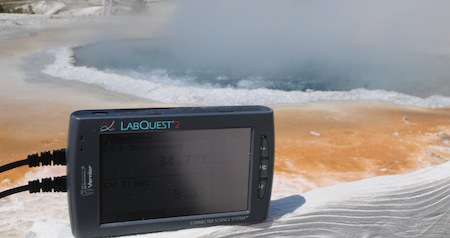Kicking the tires on the LabQuest 2 and its Connected Science System
By Martin Horejsi
Posted on 2012-05-23
A couple weeks ago, Vernier released their Graphical Analysis App for iOS providing a functional wireless interface with their LabQuest 2 and the iPad.
We took a LabQuest 2 and an iPad running Vernier’s Graphical Analysis App for a quick spin in Yellowstone National Park this weekend to explore the connectivity and general features. We found the LabQuest 2 an impressive combination of capabilities further dissolving the interference of the operation of the technology while preforming real-time data collection.
So in a nutshell…
Our data collection was focused on the temperature and pH. Initial runs used the LabQuest 2 as a standalone device. The sensor auto detect was quite fast, and the default display options were appropriate. Although the backlighting had to be turned to its brightest to see the display in full sunlight, glare was not as much of a problem as it is with the iPad’s glass surface. On a side note, polarized sunglasses have much less of an effect on the LabQuest 2 compared to the iPad that is only readable when viewing the screen in landscape mode requiring the use of the screen rotation lock switch to maintain viewing consistency.
As a quick data collection tool, the user interface and speedy startup of the LabQuest 2 is simple and fast enough eliminate the device as a barrier to use. Turn it on and go. Past probeware interfaces often required moments to minutes of setup that were sometimes just enough to prevent data collection on a whim.
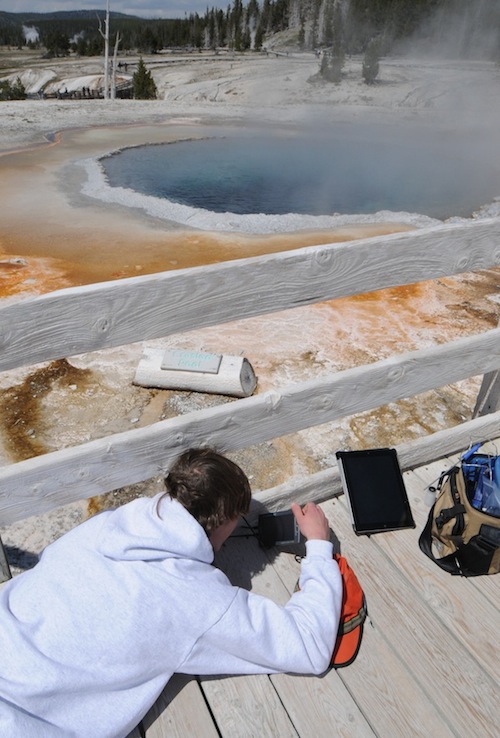
Yellowstone National Park provided the LabQuest 2 and iPad and almost infinite number of exciting data collections.
Connecting to the iPad was surprisingly quick given that the LabQuest 2 provides a scanable QR code for iPad to use rather than entering the IP address by hand. Using a QR code reading App (we used the App called Scan) and the iPad camera, the connection was made in a split second. Literally. And this is all done completely independent of an established wireless network as there were no other wi-fi networks nearby because our preliminary testing arena was none other than the geyser basin at the Old Faithful complex of Yellowstone Park.
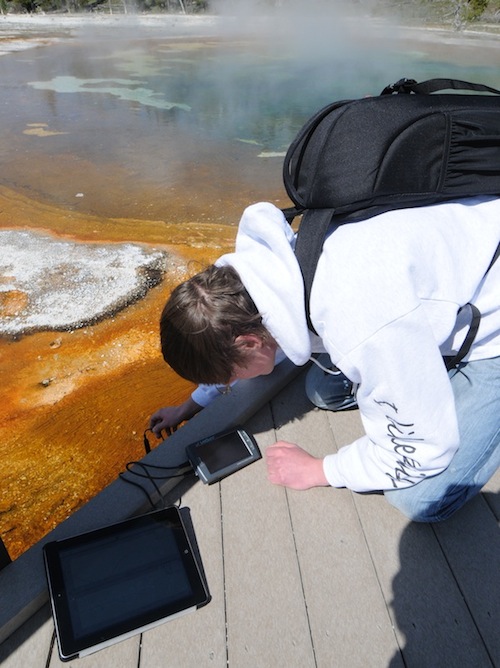
Yellowstone provided large number of data collection opportunities without breaking any of the park rules. Unlike the person in the video below from our trip to the Park last year
[youtube]http://www.youtube.com/watch?v=iu5p2HPyOwg[/youtube]
The high school student using the LabQuest 2 had never used a probeware interface before today, and only marginally experience with an iPad. The probes were dropped into the runoff streams from various geysers and hot pools. In one particular case, a small geyser eruption sprayed the LabQuest 2 while we watched the data stream on the iPad from a safe distance. It would make sense that sealing the LabQuest in a plastic bag as it feeds its radio waves to nearby iPads would dramatically increase the scope of outdoor data collection.
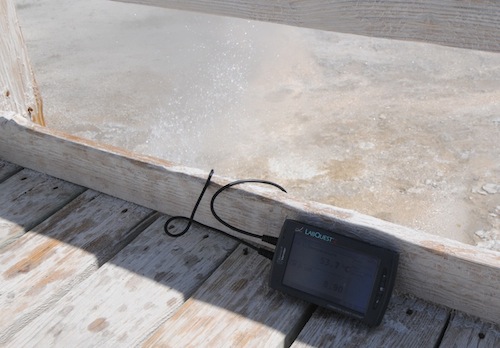
An erupting geyser splashes hot water on the boardwalk and LabQuest 2. We were standing a safe distance away watching the real-time data stream wirelessly to our iPad.
We did permanently lose the connection between the LabQuest 2 and iPad when both were turned off and then restarted, but when the LabQuest 2 was left on, the iPad had no trouble reconnecting after it would time-out or be shut off (but not fully shut down). However, the QR code made any necessary reconnection almost instantaneous. We had to shade the LabQuest 2’s screen to get the iPad QR code scanner to read.
Now that we have a better understanding of the connectivity-side of the LabQuest 2 and Graphical Analysis App, a more in-depth and deliberate inspection of the operating potential is needed. So stay tuned.
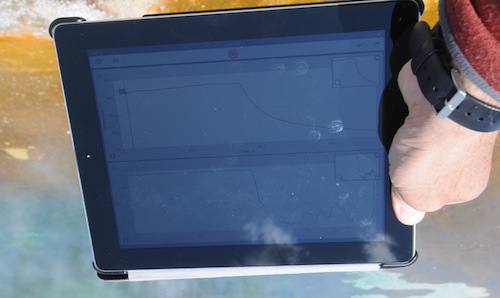
The large screen of the iPad is leveraged by the LabQuest 2 providing plenty of discussion real estate in a colorful multitouch environment.
It seemed obvious that the LabQuest 2 would be a real game changer in the data collection space, but after our field test, it seems more that the LabQuest 2 has invented an entirely new game. However, ultimately it falls on the teachers and students to truly imagine the potential of this technology. In fact, I’d even go so far as to say that human imagination is the main limit of Vernier’s Connected Science System right now.
A couple weeks ago, Vernier released their Graphical Analysis App for iOS providing a functional wireless interface with their LabQuest 2 and the iPad.
We took a LabQuest 2 and an iPad running Vernier’s Graphical Analysis App for a
Vacation activities for students
By Mary Bigelow
Posted on 2012-05-22
 How do you get families and students to participate in science in the summer? I’m looking for ideas to engage upper elementary students.
How do you get families and students to participate in science in the summer? I’m looking for ideas to engage upper elementary students.
–Amber, Minnesota
Even though people say students need a break, isn’t it ironic that by midsummer, newspaper articles appear advising parents what to do when kids say they’re bored? Teachers also are concerned about the “summer slump,” a backsliding of skills and knowledge that occurs when students are not actively involved in practicing or extending what they learned during the academic year. As the contents of the April/May Science & Children suggest, “Learning Doesn’t Take a Vacation,” and parents may welcome ideas for science activities that can be done as a family.
Take-home packets of coloring pages or word searches may keep students busy, but their value in terms of science learning is limited. Hands-on projects may be of more interest to students and their parents or other caregivers. However, requiring all students to complete any set of take-home summer activities has some drawbacks. Some students will participate in family vacations or camps, with their own planned activities. Others spend time away from home with day-care providers. Some parents may work evenings or weekends, have other children to care for, or may not have a lot of skills or self-confidence to assist their children. Even giving extra credit for summer work penalizes students who don’t have resources at home.
But don’t give up on finding ways to connect students and parents/caregivers through enjoyable, informal science activities. Many teachers send newsletters or add ideas to a calendar on their own or the school’s website. The advantage of teacher suggestions (rather than the generic ones in the newspaper) is they can be tailored to a specific age group and connected to the curriculum.
Are there topics you couldn’t get to this year or ones your students found especially interesting? Provide a list of books or websites for students and parents to explore in greater detail. Or suggest books and websites related to the topics students will address next year, giving students the opportunity to preview and increase their prior knowledge and experiences. NSTA’s SciLinks can help you create a list of appropriate websites to share with students and parents.
The Get Ready for Summer page on the Reading Rockets website has a “beach bag” full of ideas for younger children, including science-related ones. Home Experiments and Kitchen Science Experiments have both demonstrations and experiments. Experiments from Science Bob also has a section on “make it an experiment” with suggestions on how to extend the demonstration into an investigation. The Exploratorium is always a good source for hands-on science activities. You could make specific recommendations or encourage parents to choose activities of interest.
Encourage students to keep a summer journal, either on paper or as an online blog to record their experiences (with assistance from their parents). Include places to record descriptions of investigations, a weather diary, observations when taking a walk, observations of constellations or cloud formations, a travel diary, or a place to jot down questions.
Suggest prompts for family conversations (What is your first memory of being outdoors? How have inventions and technology changed over the years? Play I Spy at home and find objects made of metal, plastic, glass, or wood. Talk about where food comes from.)
Give each student a take-home plant to nurture and record observations. Monitor a bird feeder (even better if students make them) or observe insects or family pets and describe their behavior. Assemble collections of leaves, pressed flowers, interesting rocks, or photos of interesting objects. Use common items to make a musical instrument, design an invention, or create a work of art. Help with cooking to practice following a recipe and measuring. (See the Exploratorium’s Science of Cooking).
Encourage parents to take children outside and talk to them about what they observe in their surroundings. Provide information and links to the local library and to nearby museums, zoos, and parks. Many of these organizations have free or inexpensive summer programs for children and families. (I volunteer at a nature center, and I’m surprised at the number of people who say that they had never heard of the center or they did not know that the resources—walking trails, picnic tables, and a museum—are free.)
Offer to share your summer suggestions with daycare providers and community groups running activities or camps for children.
Unfortunately, not every family will take advantage of your suggestions. If you have parents’ email addresses, perhaps a gentle reminder would help, especially when the news articles about summer boredom appear.
Photo: http://www.flickr.com/photos/adwriter/164336504/sizes/s/in/pool-1701103@N22/
 How do you get families and students to participate in science in the summer? I’m looking for ideas to engage upper elementary students.
How do you get families and students to participate in science in the summer? I’m looking for ideas to engage upper elementary students.
–Amber, Minnesota
Chemistry Now,chemistry of plastics: polyethelene
By admin
Posted on 2012-05-21
 Polyethelene. Most people would be hard pressed to NOT to have some in their possession at any given moment. This chance discovery has completely revolutionized the “stuff” in our lives over the last 65 years. Let students discover how by using the assets in this lesson package, part of the “Chemistry Now” series created by the partnership of NBC Learn, NSF, and NSTA.
Polyethelene. Most people would be hard pressed to NOT to have some in their possession at any given moment. This chance discovery has completely revolutionized the “stuff” in our lives over the last 65 years. Let students discover how by using the assets in this lesson package, part of the “Chemistry Now” series created by the partnership of NBC Learn, NSF, and NSTA.
Use the video Chance Discoveries: Polyethylene in your chemistry or physical science course when discussing monomers and polymers. Or use it along with the other videos and materials in the package to spark debates in your environmental science class or emphasize the history of science. One video on the Pacific garbage patch that first aired in 2007 provides background for 2012 news releases on the same subject.
And don’t forget your teammates and colleagues in other disciplines. With plastic’s connection to the economics of WWII, develop a cross-curricular project using these assets as a springboard.
However you decide to incorporate them in your instruction, let us know how it worked out!
—Judy Elgin Jensen
Photo of art installation made of plastic collected on beaches near Nye Beach, Oregon by Maureen Moca.
Video: “Chance Discoveries: Polyethylene,” tells how three different chemists in two countries over more than 30 years happened to make a white, waxy substance during lab experiments that, once recognized as potentially useful and developed, became polyethylene—the most common plastic in the world.
Video: In the news report “Water Fight: bottled vs. Tap,” environmentalists urge people to drink tap water from refillable containers instead of disposable plastic bottles.
Video: In the news report “In the Bag: Are Paper or Plastic Bags Better for the Environment?” the pros and cons of each are described.
Video: The news report “Discarded: Nondegradable Plastic a Hazard to Marine Life” describes the so-called Pacific garbage dump and the impact of discarded and nondegradable plastics on marine life.
Video: The 1945 General Electric filmstrip “The Kingdom of Plastics” uses the graphics and descriptions of the day to explain the chemistry of plastics and their importance in WWII and the future.
Middle school lesson: This lesson guides students in making their own polymers.
High school lesson: In this lesson, students conduct an investigation about polymers.
You can use the following form to e-mail us edited versions of the lesson plans:
[contact-form 2 “ChemNow]
 Polyethelene. Most people would be hard pressed to NOT to have some in their possession at any given moment. This chance discovery has completely revolutionized the “stuff” in our lives over the last 65 years.
Polyethelene. Most people would be hard pressed to NOT to have some in their possession at any given moment. This chance discovery has completely revolutionized the “stuff” in our lives over the last 65 years.
Science of NHL hockey: reflexes & reaction time
By admin
Posted on 2012-05-17
 You’re the goalie. You’re padded down in an extra 10 kg of gear. You know the puck is “over there” somewhere. Then you catch it with your eye, screaming at you from the blue line. But before you really see it, your arm is already moving your glove into position. SMACK!!! The frozen hunk of rubber hits your glove. SAVE!!!
You’re the goalie. You’re padded down in an extra 10 kg of gear. You know the puck is “over there” somewhere. Then you catch it with your eye, screaming at you from the blue line. But before you really see it, your arm is already moving your glove into position. SMACK!!! The frozen hunk of rubber hits your glove. SAVE!!!
While reaction time is critical in many sports, defending the goal from a puck speeding toward you at 120 kph or more requires especially quick reflexes. NHL goalies have lots of equipment designed to help stop pucks, but their most valuable tool is their brain. Use this lesson package, developed by NBC Learn in partnership with NSTA and NSF to heighten students’ understanding of reflexes as they explore their own.
Remember, after you view the video and use the lessons, we’d love to hear from you about how they worked.
—Judy Elgin Jensen
Photo of goalie in action by Les Stockton
Video: “Reflexes & Reaction Time” explains what sparks the nerve impulses that travel to the limbs, allowing the goalie to see and react quickly enough to make a save.
Middle school lesson: In this lesson, students explore reflexes and other stimulus-response reactions and design and investigate reflex reaction time.
High school lesson: In this lesson, students investigate reaction time and hypothesize how distractions impact their results.
You can use the following form to e-mail us edited versions of the lesson plans:
[contact-form 2 “ChemNow]
 You’re the goalie. You’re padded down in an extra 10 kg of gear. You know the puck is “over there” somewhere. Then you catch it with your eye, screaming at you from the blue line. But before you really see it, your arm is already moving your glove into position. SMACK!!! The frozen hunk of rubber hits your glove. SAVE!!!
You’re the goalie. You’re padded down in an extra 10 kg of gear. You know the puck is “over there” somewhere. Then you catch it with your eye, screaming at you from the blue line. But before you really see it, your arm is already moving your glove into position. SMACK!!! The frozen hunk of rubber hits your glove. SAVE!!!
Drawn to science education
By Mary Bigelow
Posted on 2012-05-15
Studying Science Teaching and Learning Through Drawings
I came across this fascinating study via a tweet the other day. I read many traditional research studies (both quantitative and qualitative) but this one caught my attention because it used drawings as a way of communicating and data collecting. According to the authors (a team form the University of Maryland and other institutions), the study examines “how the science teaching ide ntity of the teacher interns/teachers changed over time” based on their internship experiences. Rather than a traditional questionnaire or observations, this study used drawings as evidence, along with interviews and written responses. Periodically through the study, the teacher-participants responded to two prompts: Draw Yourself Teaching Science and Draw Your Students Learning Science.
ntity of the teacher interns/teachers changed over time” based on their internship experiences. Rather than a traditional questionnaire or observations, this study used drawings as evidence, along with interviews and written responses. Periodically through the study, the teacher-participants responded to two prompts: Draw Yourself Teaching Science and Draw Your Students Learning Science.
The methodology and the scoring rubric are provided. What’s really interesting are the examples of drawings at the rubric levels and how they represent different levels of the teacher’s self-image and reflections on the teaching and learning processes and the roles of teachers and students in these processes.
Another part of the website is the section for “Educators” with ideas on how the process can be used for lesson plans, action research, and professional development.
- The lesson plans have suggestions for asking students (of any age) to draw their interpretation of science learning. Follow-up discussion questions are included.
- There is a description of the action research process and how drawings can be a data tool. I could see the process used at the beginning and end of the school year to examine an changes in student attitudes and perceptions.
- The “Try It” section has suggestions for exploring our own perceptions as teachers. This could be an interesting ice-breaker activity for a PD session or for personal reflection.
This project focused on teaching and learning in science. You may already be familiar with instruments in which students draw pictures to represent their conceptions and misconceptions about scientists and their work: Draw a Scientist Test (Wikipedia description), Who’s the Scientist, The Scientists and Artist in All.
Graphic: http://drawntoscience.org/index.html
Science of NHL hockey: statistics & averages
By admin
Posted on 2012-05-15
 NHL hockey is a game of numbers—statistics that is. Fans may cheer on a team because of where they’re from, their team mascot, or the atmosphere of the stadium. Fans may like a certain player because of how hard he hits, how fast he skates, or how cute he is. But until you delve into the statistics of the players and the team overall, it’s impossible to tell who’s better.
NHL hockey is a game of numbers—statistics that is. Fans may cheer on a team because of where they’re from, their team mascot, or the atmosphere of the stadium. Fans may like a certain player because of how hard he hits, how fast he skates, or how cute he is. But until you delve into the statistics of the players and the team overall, it’s impossible to tell who’s better.
Statistics are one way scientists, and hockey fans, can be objective about their conclusions. The numbers don’t lie. Unless, of course, you happen to have the same opinion as Mark Twain, who in his autobiography noted that there are “lies, damned lies, and statistics.”
One thing that’s not a lie is the excitement this series of lesson packages will bring to your instruction! Although we have no statistics to back that up, take our word for it. For sure, NSTA, NBC Learn, and NSF wouldn’t lie to you. Get together with your team or colleagues in other departments and use The Science of NHL Hockey as a focus for end-of-year projects that can be independent of the dates you have to turn in textbooks and library access. Remember, the Stanley Cup playoffs are in full swing during May every year. Plenty of statistics to work with there!
—Judy Elgin Jensen
Photo of NHL infographic by Darren Barefoot.
Video: “Statistics & Averages” shows that being a top goalie in the NHL takes more than quick reflexes and nerves of steel, it also requires a firm grip on the numbers—namely, the key averages and statistics of goaltending.
Middle school lesson: In this lesson, students explore numerical and nonnumerical data and design an investigation to find out more.
High school lesson: In this lesson, students will design and carry out an investigation to collect a set of data and find the mean, median, mode, and range of a set of data.
You can use the following form to e-mail us edited versions of the lesson plans:
[contact-form 2 “ChemNow]
 NHL hockey is a game of numbers—statistics that is. Fans may cheer on a team because of where they’re from, their team mascot, or the atmosphere of the stadium. Fans may like a certain player because of how hard he hits, how fast he skates, or how cute he is. But until you delve into the statistics of the players and the team overall, it’s impossible to tell who’s better.
NHL hockey is a game of numbers—statistics that is. Fans may cheer on a team because of where they’re from, their team mascot, or the atmosphere of the stadium. Fans may like a certain player because of how hard he hits, how fast he skates, or how cute he is. But until you delve into the statistics of the players and the team overall, it’s impossible to tell who’s better.
Chemistry Now: chemistry of changing leaves
By admin
Posted on 2012-05-14
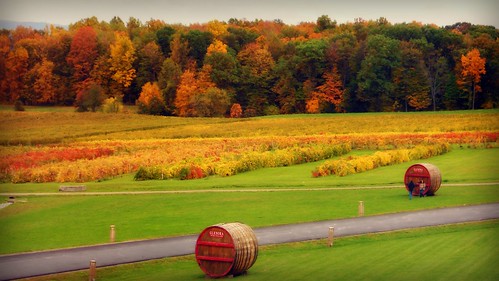 Think autumn leaves.
Think autumn leaves.
OK, sing along now … The falling leeeeaves drift by the windoooow. The autumn leeeeaves of red and goooold …
OK, maybe not!
Instead, explore why the autumn leaves are red and gold. Use the video Chemistry of Changing Leaves as an introduction to plant leaves and pigments or to connect life and space science in a discussion of Earth’s seasons. The video is just one of the “Chemistry Now” series, in which NSTA and NBC Learn have teamed with NSF to create lessons related to common objects in our world and the changes they undergo every day.
Other videos in this NBC Learn collection (linked below) include a 21st Century Chemist profile and historical and modern NBC News profiles on plant research and Sweden’s goal to become fossil fuel free by 2020. After you view the videos and try the lessons, please leave comments below each posting about how well the materials worked in real-world classrooms.
And if you can’t get those first two lines of that song out of your head, do an Internet search for Nat King Cole Autumn Leaves … smoooooooth!
—Judy Elgin Jensen
Photo of autumn leaves in Dundee, New York by Barbara Miers
Video: “Chemistry of Changing Leaves,” explains the role of the pigment molecule chlorophyll when tree foliage in northern areas changes in autumn from green to shades of yellow, orange and red.
Video: In this 21st Century Chemist profile, “”Green” NC State Chemist Looks for Cleaner, Safer Fuel Process,” North Carolina State University chemist Dr. Elon Ison explains his research on catalysts that could be used to make alternative fuels.
Middle school lesson: This lesson guides students in observing pigments in leaves.
High school lesson: In this lesson, students conduct a chromatography investigation using leaf pigments.
You can use the following form to e-mail us edited versions of the lesson plans:
[contact-form 2 “ChemNow]
 Think autumn leaves.
Think autumn leaves.
OK, sing along now … The falling leeeeaves drift by the windoooow. The autumn leeeeaves of red and goooold …
OK, maybe not!



